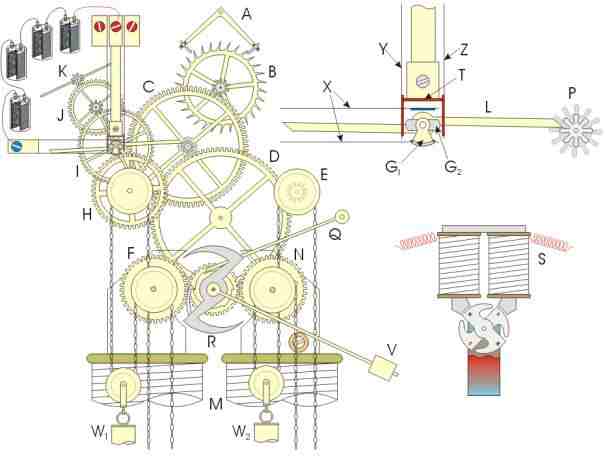
Wagner

The principle of this clock relies on the electro-magnetically winding of weights using a Huygens chain. There are two separate parts to be distinguished in this clock: the movement to drive the hands and the contacting system to send polarized signals to the slaves and to initiate winding the weights.
The movement consists of winding wheel E, minute wheel D, middle wheel C and escape wheel B, governed by anchor A. The minute hand is fitted to the arbor of the minute wheel. Weight W2 provides the energy and is continuously rewound by a remontoire consisting of electro-magnet M and its rotor R.
The contacting system consists of winding wheel H, second wheel I, middle wheel J and vane K. Weight W1 provides the energy to turn these wheels and is lifted at the same time as weight W2 is. Fixed to the axis of wheel I is lever L, having two arms, and contact G, having a V-shaped part (G1) and an O-shaped part (G2).
Contact G is placed between a set of contact springs X and contact springs Y and Z. Contacts X are connected to the - pole of the battery, while contacts Y and Z each are connected to the terminals of the electro-magnet of slave S and to electro-magnet M.
At rest, contacts Y and Z are short-circuited by contact T, connected to the + pole of the battery, and in this position both terminals of slave and remontoire are connected to one side of the battery. One arm of lever L rests on a leaf of an extra pinion P fixed to the axis of middle wheel C of the movement.
As the potential energy of weight W2 turns the wheels, pinion P turns anticlockwise and releases lever L each minute. After the tip of the right arm of lever L has dropped from the leaf of pinion P, arm L will make half a revolution until its other arm is stopped by the next leaf of pinion P.
The wing of contact G1 will now deflect contact spring Y and in doing so will disconnect it from the + pole of the battery. A little later contact G2 will make contact with contact springs X and so contacts X and Y are electrically connected.
Now one terminal of slave and remontoire is connected to the - pole of the battery (contact Y) while the other terminal is still connected to the + pole of the battery (contact Z). The electro-magnet of the slave is energized and its rotor (the poles of this rotor having different polarities under the influence of a permanent magnet) will turn 90 degrees clockwise, at the same time the electro-magnet of the remontoire is energized. Both weights W1 and W2 are lifted and their potential energy restored as rotor R turns wheels F and N.
Lever L will continue to revolve and eventually G2 departs from contact spring X and G1 gently replaces contact spring Y. As the current ceases weight V replaces rotor R to its original position while backstop Q prevents wheels F and N from turning back.
The next minute these series of events will be repeated except that now G1 will first deflect contact spring Z before G2 makes contact with contact springs X. This time the other terminal of slave and remontoire is connected to the - pole of the battery and so the current flows in opposite direction. North and south poles of the electro-magnet of slave S have changed but so have the poles of its rotor, thus the rotor will turn another 90 degrees, again in clockwise direction. The polarity of the poles of electro-magnet M of the remontoire has also changed, but since rotor R has no polarity this makes no difference.